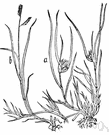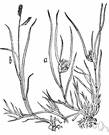buf·fa·lo·grass
or buffalo grass (bŭf′ə-lō-grăs′)n.
A mat-forming perennial grass (Bouteloua dactyloides syn. Buchloe dactyloides) native to the plains of central North America, important as a forage grass and sometimes used for lawns.
American Heritage® Dictionary of the English Language, Fifth Edition. Copyright © 2016 by Houghton Mifflin Harcourt Publishing Company. Published by Houghton Mifflin Harcourt Publishing Company. All rights reserved.
buffalo grass
n
1. (Plants) a short grass, Buchloë dactyloides, growing on the dry plains of the central US
2. (Plants) Austral a grass, Stenotaphrum americanum, introduced from North America
Collins English Dictionary – Complete and Unabridged, 12th Edition 2014 © HarperCollins Publishers 1991, 1994, 1998, 2000, 2003, 2006, 2007, 2009, 2011, 2014
buf′falo grass`
n.
a short grass, Buchloë dactyloides, having gray-green blades, prevalent on the dry plains east of the Rocky Mountains.
Random House Kernerman Webster's College Dictionary, © 2010 K Dictionaries Ltd. Copyright 2005, 1997, 1991 by Random House, Inc. All rights reserved.
ThesaurusAntonymsRelated WordsSynonymsLegend:
| Noun | 1. |  buffalo grass - low mat-forming grass of southern United States and tropical America; grown as a lawn grass buffalo grass - low mat-forming grass of southern United States and tropical America; grown as a lawn grassgrass - narrow-leaved green herbage: grown as lawns; used as pasture for grazing animals; cut and dried as hay genus Stenotaphrum, Stenotaphrum - lawn grasses |
| 2. |  buffalo grass - short grass growing on dry plains of central United States (where buffalo roam) buffalo grass - short grass growing on dry plains of central United States (where buffalo roam)grass - narrow-leaved green herbage: grown as lawns; used as pasture for grazing animals; cut and dried as hay Buchloe, genus Buchloe - buffalo grass |
Based on WordNet 3.0, Farlex clipart collection. © 2003-2012 Princeton University, Farlex Inc.